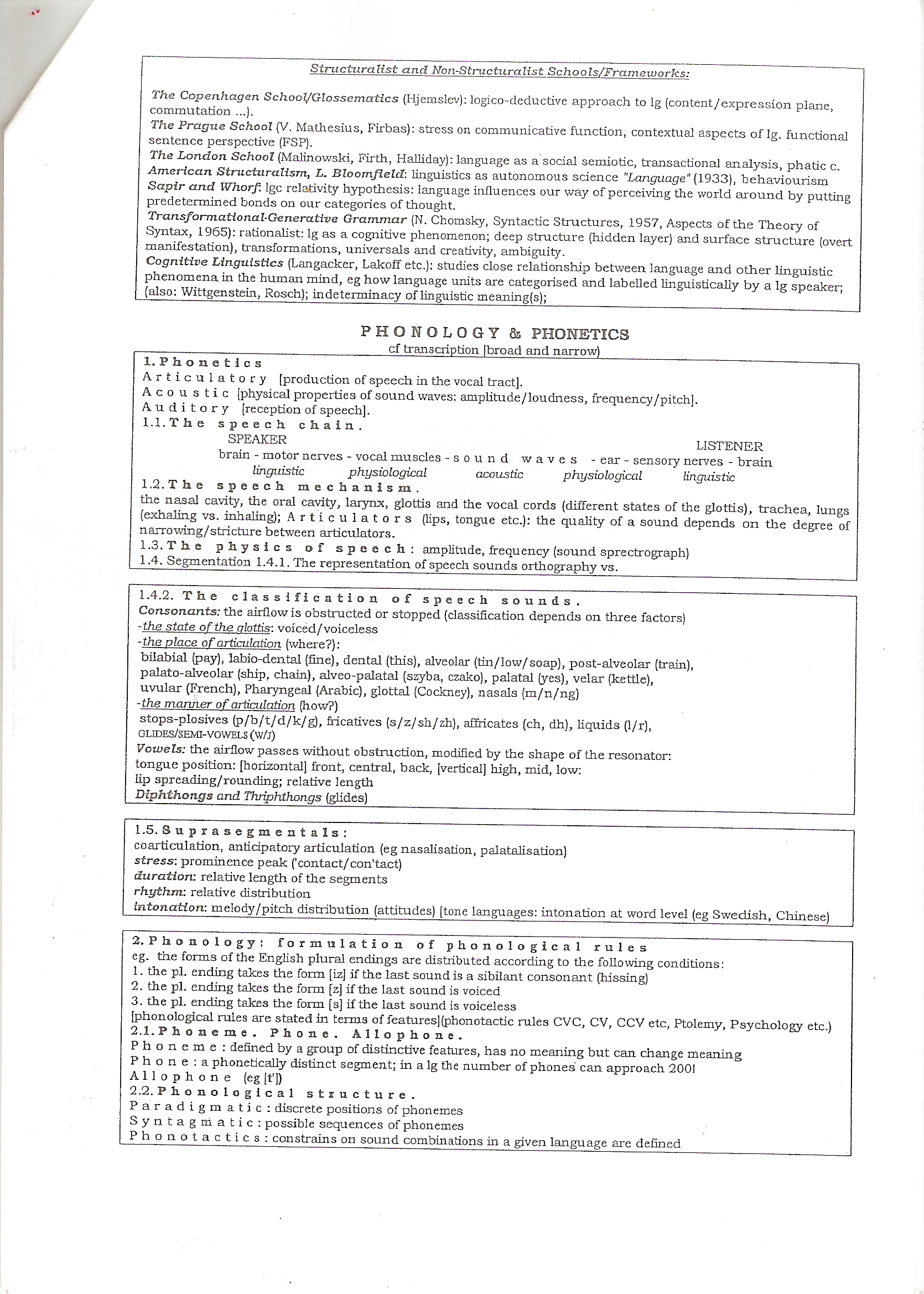lingwistyka 3

Structuralist and NonStructuralist Schools/Frameworks:
The Copenhagen School/Glossematics (Hjemslev): logico-deductive approach to lg (content/expression piane, comroutation ...).
The Pragnę School (V. Mathesius, Firbas): stress on coxnmunicative function, contextual aspects of lg. functional sentence perspective (FSP).
The London School (Malinowski, Firth, Halliday): language as a social semiotic, transactional analysis, phatic c. American Structuralism, L. Bloomfleld: liaguistics as autonomous science "Language" (1933), behaviouxism Sapir and Whorf. lgc relativity hypothesis: language influences our way of perceiving the world around by putting predetermined bonds on our categories of thought.
Transformational-Generative Grammar (N. Chomsky, Syntactic Structures, 1957, Aspects of the Theory of Syntax, 1965): rationalist: lg as a cognitive phenomenon; deep structure (hidden layer) and surface structure (overt manifestation), transformations, universals and creativity, ambiguity.
Cognitite Linguistics (Langacker, Lakoff etc.): studies close relationship between language and other linguistic phenomena in the human mind, eg how language units are categorised and iabelled linguistically by a łg speaker; (also: Wittgenstein, Rosch); indetcrminacy of linguistic meaning(s);_
PHONOLOGY & PHONETICS
_cf transcription [broad and narrow)_
l.Phonetlcs
Articulatory [production of speech in the vocal tract].
Acoustic (physical properties of sound waves: amplitude/loudness, freąuency/pitchj.
Audi tory (reception of speech].
1.1. The speech chain.
SPEAKER LISTENER
brain - motor nerves - vocal muscles - sound w a v e s - ear - sensory nerves - brain hngudstic physiological acoustic physiological linguistic
1.2. The speech mechanism.
the nasal cavity, the orał cavity, laiynx, glottis and the vocal cords (difFerent States of the glottis), trachea, lungs (exhaling vs. inhaling); Articulators (lips, tongue etc.): the quality of a sound depends on the degree of narrowing/stricture between articulators.
1.3. The physics of speech: amplitudę, freąuency (sound sprectrograph)
1.4. Segmentation 1.4.1. The representation of speech sounds orthography vs._
1.4.2. The classification of speech sounds.
Consonants: the airflow is obstructed or stopped (classification depends on three factors) -the state of the glottis: voiced/voiceless •the place of articulation (where?):
bilabial (pay), labio-dental (fine), den tal (this), alveolar (tin/low/soap), post-alveolar (train), palato-alveolar (ship, chain), alveo-palatal (szyba, czako), palatal (yes), velar (kettle), uvular (French), Pharyngeal (Arabie), glottal (Cockney), nas ais (m/n/ng)
-the maruier of articulation (how?)
stops-plosives (p/b/t/d/k/g), fiicatives (s/z/sh/zh), affiicates (ch, dh), liąuids (1/r), GLIDES/SEMI-VOWELS (W/j)
Vowels: the airflow passes without obstruction, modified by the shape of the resonator: tongue position: [horizontalj front, central, back, jvertical] high, mid, Iow: lip spreading/rounding; relative length
Diphthongs and Thriphthongs (glides)_
1.5. Suprasegmentals:
coarticulation, anfidpatory articulation (eg nasalisation, palatalisation) stress: prominence peak fcontact/con'tact) duration: relative length of the segments rhythm: relative distribution
intonatiom melody/pitch distribution (attitudes) (tonę languages: intonation at word level (eg Swedish, Chinese)
2. Phonology: formulation of phonological rules
eg. the forms of the English plural endings are distributed according to the following conditions:
1. the pl. ending takes the form [iz] if the last sound is a sibilant consonant (hissing)
2. the pl. ending takes the form [z] if the last sound is voiced
3. the pl. ending takes the form [s] if the last sound is voiceless
{phonological rules are stated in terma of features|(phonotactic rules CVC, CV, CCV etc, Ptolemy, Psychology etc.)
2.1. Phoneme. Phone. Allophone.
Phoneme : defined by a group of distinctive features, has no meaning but can change meaning P h o n e : a phoneticalły distinct segment; in a lg the number of phones can approach 2001 Allophone (eg|t*J)
2.2. P h o n o 1 o g 1 c a 1 structure.
Parad igm atic: discrete positions of phonemes Syntagmatic: possible seąuences of phonemes
Phonotactics: constrains on sound combinations in a given language are defined__
Wyszukiwarka
Podobne podstrony:
Structure and Thermoelectric Properties of the Vapor-Phase Condensation LAST Rostyslay Jaworski. Jar
i. Introduction CCT diagrams are used for detennination of the phase structure and hardness of steel
THE INFLUENCE OF THE GROWTH TEMPERA TURĘ ON STRUCTURAL AND... 161 c.d. tab.
SMALL GRANULE POTATO STARCH. STRUCTURE AND USABILITY 89 Smali granule and standard starch samples re
18 Felczak T., Domańska T. THE STRUCTURE AND LEVEL OF DEBT AND THE EFFICIENCY OF INDIVIDUAL FARMS, D
* BOOKS AND PAMPHLETS The Theory of continuous structures and arches, by Charles M. Spofford. New Yo
my committee - Timothy Taylor, Anthony Seeger, and Mitchell Morris - enriched the theoretical framew
1. System of education and its legał basis The legał basis for the school education system in force
Tax expenditures: spending through the Polish tax system 95 comprise the nonnal tax structure and re
03 (2) Name_& The Schoolbus % Cofor ihe bus and tho wheels. Cul out ihe wheels and pastę łbem on
2 (1621) CONTENTSSUMMARY OF1 Structure and functions of skin and coat Chiara Nołi
95 (145) attained. It may be necessary to stretch the muscles and other structures in order to lock
1558eab299c6a7ce494611bfaa30d635 1 Educate about the structure and process of Iherapy Define present
dont sieep enough, it s bad for their health and their schoolwork. again for This Are the sentences
więcej podobnych podstron